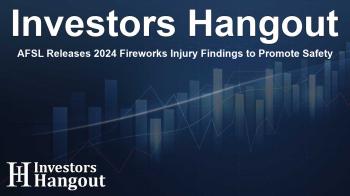AFSL Releases 2024 Fireworks Injury Findings to Promote Safety

AFSL's Commitment to Fireworks Safety and Standards
The American Fireworks Standards Laboratory (AFSL) has launched its first Annual Fireworks Injury Report for 2024, marking a significant step in its mission to enhance consumer safety. Established as the foremost independent organization for fireworks safety and standards, AFSL aims to create a safer environment for fireworks use through rigorous testing and data transparency.
Filling the Gap in Fireworks Safety Reporting
With the discontinuation of the annual report by the U.S. Consumer Product Safety Commission (CPSC), AFSL utilizes the same government data sources and methodologies to maintain accuracy in reporting. This ensures that the data remains consistent and authentic, keeping public safety as the paramount focus. AFSL has raised concerns regarding the increase of untested and uncertified fireworks that are entering the market, which poses a risk to consumers everywhere.
The Executive Director's Insights
Jay Howell, Executive Director of AFSL, emphasizes the threats posed by untested fireworks: "We continue to see evidence of untested fireworks, including overloaded reloadable aerial shells being sold to consumers. These products are not traceable and can lead to serious injuries or fatalities." His commitment to public safety drives the organization's ongoing initiatives.
Key Statistics from the 2024 Injury Report
The report outlines several crucial findings from the latest data:
- Approximately 14,741 fireworks-related injuries were recorded in U.S. emergency rooms for the year.
- 76% of those injuries were classified as minor and received on-site treatment, while 22% necessitated hospitalization.
- The report confirmed 19 fatalities, with a significant number resulting from improper handling of reloadable aerial shells.
- Adults aged 30+ represented 42% of total injuries.
- There was a notable rise in injuries tied to sparklers and small devices among older users.
Understanding the Risks
Although many injuries are minor, the report points out that mishandling—especially with reloadable devices—remains the primary cause of severe injuries. AFSL encourages consumers to avoid launching fireworks from their bodies, throwing them, or using fireworks while impaired. Furthermore, purchasing items from unlicensed vendors poses significant safety risks.
Ongoing Safety Initiatives by AFSL
Since 2015, AFSL's rigorous safety inspections have safeguarded over 83 million cases of fireworks, rejecting more than 4.4 million due to safety concerns. Their reported testing primarily meets or exceeds stringent federal regulations, solidifying safety in consumer fireworks. However, there is a pressing need to address the inflow of professional-grade fireworks entering the consumer market through dubious channels.
Essential Guidelines for Fireworks Safety
AFSL's mission to ensure safe fireworks use extends to educating the public on critical safety guidelines:
- Always buy from licensed and reputable sellers.
- Adhere to all local laws regarding fireworks.
- Never operate fireworks while impaired.
- Avoid modifying or relighting defective fireworks.
- Never launch any fireworks from your body.
Summary of the AFSL’s Mission
The Annual Fireworks Injury Report serves not only as a record of safety incidents but also as a resource for regulators, public safety officials, and the public, promoting safer celebrations nationwide. With a focus on education and testing, AFSL strives to lead the way in enhancing the safety standards for fireworks.
About AFSL
The American Fireworks Standards Laboratory (AFSL), founded in 1989, is dedicated to improving consumer fireworks safety in the U.S. Through thorough voluntary testing, mainly conducted at manufacturing sites in various countries including China and Cambodia, AFSL ensures compliance with federal safety regulations. Covering approximately 70% of all imported consumer fireworks, the organization is unwavering in its commitment to consumer safety, making their injury report a vital tool in their ongoing efforts.
Frequently Asked Questions
What does AFSL stand for?
The acronym AFSL stands for American Fireworks Standards Laboratory.
Why was the Annual Fireworks Injury Report launched?
The report was launched to fill the void left by the CPSC's discontinuation of their annual fireworks injury reporting, ensuring continuous data on fireworks-related injuries.
What are some key findings in the 2024 report?
Some key findings include over 14,000 injuries treated, with many involving reloadable aerial shells and sparklers.
How does AFSL ensure the safety of fireworks?
AFSL conducts rigorous testing on a majority of consumer fireworks, ensuring compliance with federal safety standards and rejecting dangerous products.
What safety advice does AFSL provide to the public?
AFSL advises purchasing from licensed sellers, following local laws, and avoiding any use of fireworks while impaired.
About The Author
Contact Riley Hayes privately here. Or send an email with ATTN: Riley Hayes as the subject to contact@investorshangout.com.
About Investors Hangout
Investors Hangout is a leading online stock forum for financial discussion and learning, offering a wide range of free tools and resources. It draws in traders of all levels, who exchange market knowledge, investigate trading tactics, and keep an eye on industry developments in real time. Featuring financial articles, stock message boards, quotes, charts, company profiles, and live news updates. Through cooperative learning and a wealth of informational resources, it helps users from novices creating their first portfolios to experts honing their techniques. Join Investors Hangout today: https://investorshangout.com/
The content of this article is based on factual, publicly available information and does not represent legal, financial, or investment advice. Investors Hangout does not offer financial advice, and the author is not a licensed financial advisor. Consult a qualified advisor before making any financial or investment decisions based on this article. This article should not be considered advice to purchase, sell, or hold any securities or other investments. If any of the material provided here is inaccurate, please contact us for corrections.

